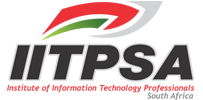PRESS RELEASE:
IITPSA introduces professional CIO recognition to SA
Professional CIO (Pr.CIOTM) now a professional designation in SA – first leading CIOs awarded accreditation
The Institute of Information Technology Professionals South Africa (IITPSA) has introduced a Professional Chief Information Officer (CIO) designation for South African ICT professionals meeting the required levels of academic achievement and professional experience. This designation is endorsed by the CIO Council of South Africa.
IITPSA CEO Tony Parry says the standards required for admission to the Professional Chief Information Officer designation ensure that practitioners admitted to this professional designation have appropriate qualifications and demonstrate a very high degree of relevant professional experience in a range of disciplines included within the ICT spectrum.
These disciplines include software, network or telecommunications engineering, information security, ICT governance, business analysis, database management, ICT management, project management, business intelligence, Enterprise Resource Planning, software design and / or development, web development, and mobile technologies.
“This designation is awarded at the highest level in the profession, and officially recognises the achievements of the individuals concerned,” says Parry.
Applicants admitted to this designation may use the post-nominal designator “Pr.CIO” in addition to the post-nominal designator for the Professional Member grade.
IITPSA membership grading and admission criteria are continuously evaluated in accordance with international practices and are maintained in line with these requirements. By gaining the right to use the respected letters AMIITPSA, MIITPSA, PMIITPSA and now also Pr.CIO after their names, IITPSA members are identified as belonging to a SAQA-recognised and IFIP IP3 accredited body and professional community. IITPSA members also benefit from Privy Seal digital accreditation stamps to append to their digital signatures.
The IITPSA membership progression pathway for ICT Practitioners is: Student Member (optional) > > Affiliate Member > > Associate Member (AMIITPSA) > > Member (MIITPSA) > > Professional Member (PMIITPSA) (registered professional designation on the NQF) > Professional CIO (Pr.CIO).
The first six CIOs to be awarded the new designation received their accreditation at a launch event in Sandton this week. They are Renier van der Merwe of Premier Foods, Martin Coetsee of DRA Global, Tshifhiwa Ramuthaga of Barloworld Logistics and Visionary CIO 2014, Yolisa Skwintshi of Absa Insurance, Visionary CIO finalist, Louise van der Bank of AfriSam and Amanda Maritz of Essilor.
Congratulating the six, Thabo Mashegoane, IITPSA’s new President, said the new designation marked a milestone in the history of the IITPSA and reflected the Institute’s evolution in line with changing industry needs.
“In recent years, we determined that the role of CIO had become crucial to the success of South African enterprises and the economy as a whole. CIOs support organisational innovation, security, compliance and growth. But identifying whether an ICT professional possessed all the qualifications, experience and characteristics necessary to be entrusted with the role of CIO had become problematic. Academic qualifications don’t tell the whole story. Years of experience don’t prove capability,” he said.
“We realised the industry as a whole needed to be able to identify a qualified, competent CIO at a glance. And those ICT professionals who have put in the hours and acquired the necessary qualifications and skills had earned the right to showcase their competence.”
Prof. Pete Janse van Vuuren, head of the CIO Council of South Africa, said the designation was much-needed in the industry. “There has been little to measure competence by. Being an engineer and having multiple PhDs doesn’t necessarily make you a good CIO. The industry needed a professional designation that qualifies what level an individual can perform on, and with Pr.CIO, IITPSA has given us the necessary standards and a vehicle to run it properly.”
Ends

